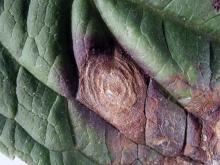See:
Hydrangea - Bacterial Leaf Spots
Cause Several fungal leaf spots have been found in the Pacific Northwest on hydrangea. The OSU Plant Clinic has found Phoma sp. most often, followed by one sample each of Alternaria sp., Ascochyta sp. and Stemphylium sp. Leaf spots due to Ascochyta sp. and Phyllosticta sp. have been found in British Columbia. Most of these pathogens overwinter in plant debris and are favored by weather or conditions that keep leaves wet for extended periods of time.
The OSU Plant Clinic has also found many leaf spots due to the bacteria Pseudomonas syringae. This bacterium is favored by cool wet weather in the spring.
Symptoms Phoma exigua - small necrotic spots surrounded by chlorotic haloes on the upper side of infected leaves. Spots may be different colors on different cultivars from small reddish-brown lesions to larger lighter-brown lesions. Infected leaves yellow and fall prematurely.
Alternaria sp.-- small brown spots with yellow haloes on the upper side of infected leaves. Lesions become dark brown or black and often coalesce into large necrotic areas. Spots occur on the leaf margins and near petioles and infected leaves fall prematurely.
Cultural control
- Space and prune bushes to permit good air circulation.
- Remove and destroy fallen leaves during the summer. If few in number, remove from the bush.
- Avoid overhead irrigation that keeps leaves wet.
Chemical control The following fungicides are registered for hydrangea and may be useful to manage these leaf spots.
- Armada 50 WDG at 3 to 9 oz/100 gal water. Do not use a silicone-based surfactant. Not for nursery or greenhouse use. Group 3 + 11 fungicide. 12-hr reentry.
- Astun at 10 to 17 fl oz/100 gal water. Group 7 fungicide. 12-hr reentry.
- Avelyo at 3 to 5 fl oz/100 gal water. Group 3 fungicide. 12-hr reentry.
- Banner MAXX at 5 to 8 fl oz/100 gal water. Group 3 fungicide. 12-hr reentry.
- Bonide Fung-onil Multi-purpose Fungicide at 2.25 teaspoons/gal water. H
- Broadform at 4 to 8 fl oz/100 gal water. Group 7 + 11 fungicide. 12-hr reentry.
- Compass 50 WDG at 1 to 2 oz/100 gal water plus an adjuvant. Do not use organosilicate additives. Group 11 fungicide. 12-hr reentry.
- Copper-based group M1 fungicides.
- Camelot O at 0.5 to 2 gal/100 gal water. 4-hr reentry.
- Grotto at 0.5 to 2 gal/30 to 100 gal water/A. Group M1 fungicide. 4-hr reentry.
- Phyton 27 at 1.3 to 2.5 oz/10 gal water. Group M1 fungicide. 48-hr reentry.
- Daconil Weather Stik at 1.38 pints/100 gal water. Foliage only. Group M5 fungicide. 12-hr reentry.
- Heritage at 1 to 4 oz/100 gal water plus a non-silicone-based wetter sticker. Group 11 fungicide. 4-hr reentry.
- Insignia SC at 3 to 6 fl oz/100 gal water plus an adjuvant. Do not use with organosilicate-based adjuvants. Use preventively only. Group 11 fungicide. 12-hr reentry.
- Mancozeb-based products can be used as mixing partners and provide some protection. Group M3 fungicides. 24-hr reentry.
- Fore 80 WP at 1.5 lb/100 gal water plus a spreader-sticker.
- Protect DF at 1 to 2 lb/100 gal water plus 2 to 4 oz spreader-sticker.
- Myclobutanil 20 EW T&O at 6 to 12 fl oz/100 gal water plus spreading agent. May observe a PGR effect. Group 3 fungicide. 24-hr reentry.
- Orkestra at 8 fl oz/100 gal water. Group 7 + 11 fungicide. 12-hr reentry.
- Ortho Rose & Flower Disease Control at 2 fl oz/gal water. Group 3 fungicide. H
- Pageant at 12 to 18 oz/100 gal water. Do not use with organosilicone-based adjuvants. Group 7 + 11 fungicide. 12-hr reentry.
- Palladium at 4 to 6 oz/100 gal water. Avoid excessive runoff to small plants, which may result in stunting and/or chlorosis. Group 9 + 12 fungicide.12-hr reentry.
- Postiva at 10 to 28 fl oz/100 gal water. Group 3 + 7 fungicide. 12-hr reentry.
- Spectro 90 WDG at 1 to 2 lb/100 gal water. Foliage only. Group 1 + M5 fungicide. 12-hr reentry
- Spectracide Immunox Multi-Purpose Fungicide Spray Concentrate for Gardens at 1 fl oz/gal water. Group 3 fungicide. H
- Terraguard SC at 4 to 8 fl oz/100 gal water. Group 3 fungicide. 12-hr reentry.
- Tourney EZ at 1 to 4 oz/100 gal water. Group 3 fungicide. 12-hr reentry.
- Trinity at 4 to 12 fl oz/100 gal water. Group 3 fungicide. 12-hr reentry.
Reference Li, Y., Mmbaga, M. T., Zhou, B., Joshua, J., Rotich, E., and Parikh, L. 2018. Diseases of Hydrangea. In McGovern, R.J. and Elmer, W.H. (eds.) Handbook of Florists' Crops Diseases. Springer Int.


